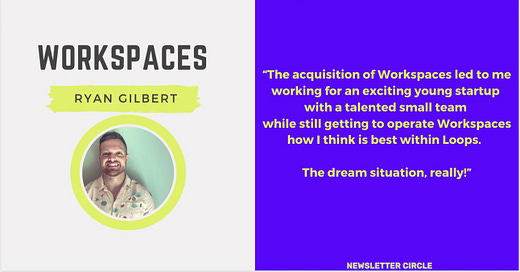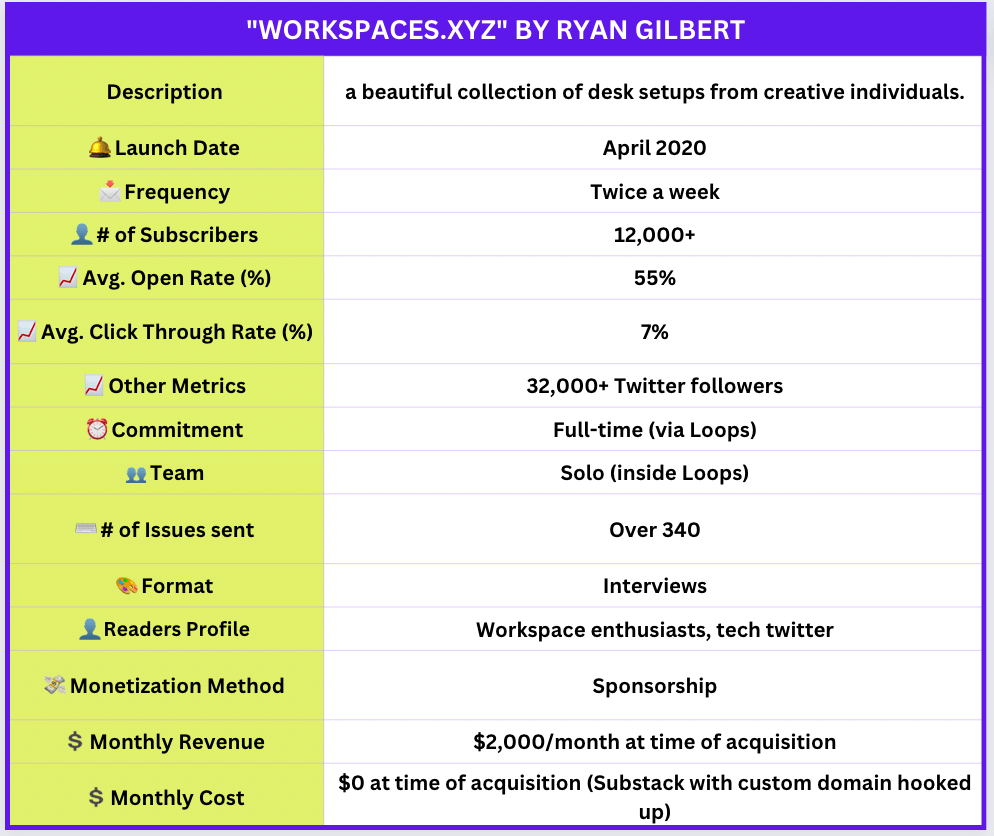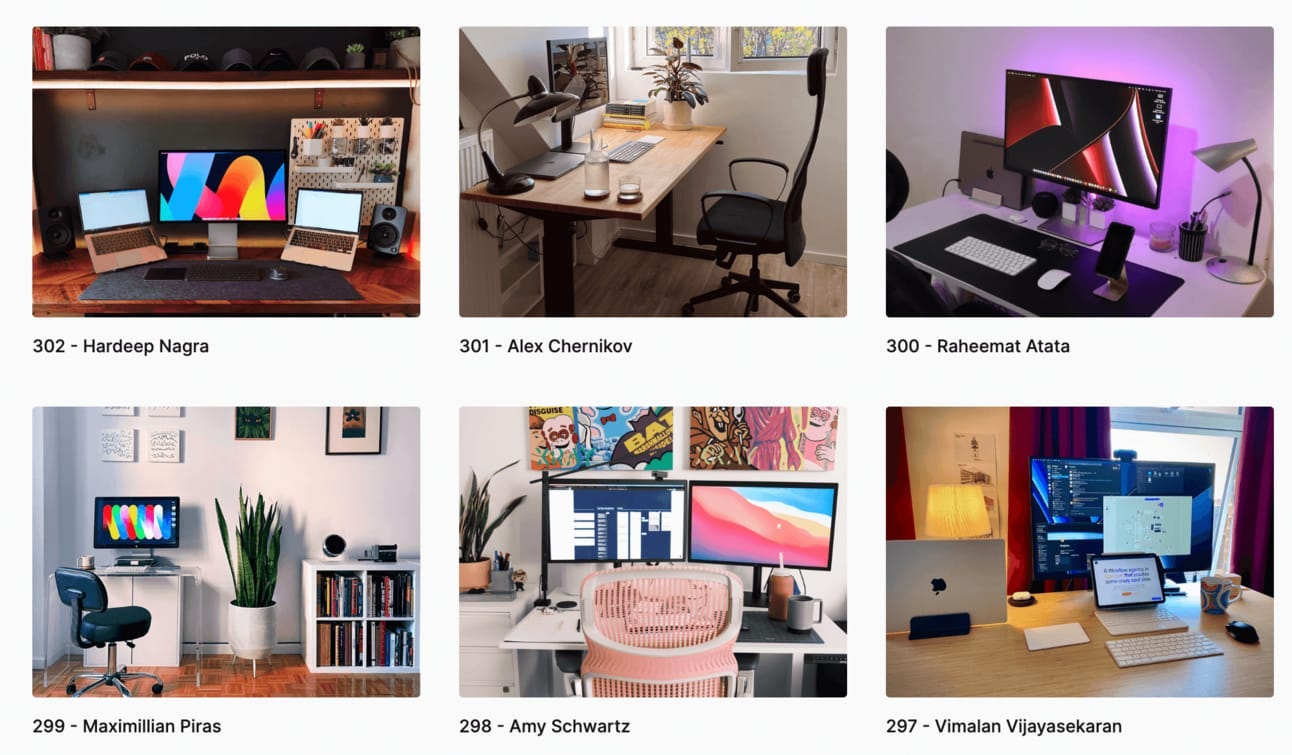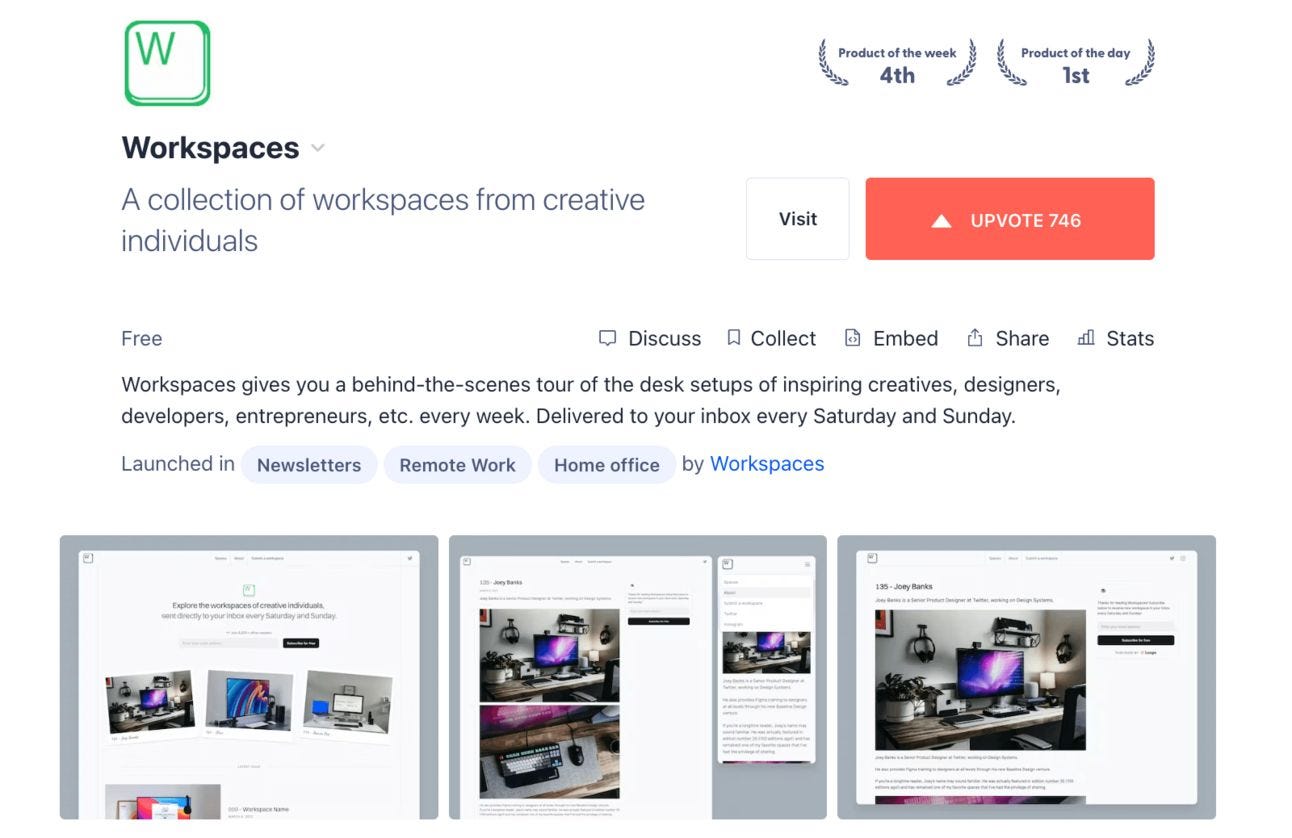Learn the secrets of successful newsletters with Newsletter Circle!
👉 Every Sunday, you will read an exclusive interview with a successful newsletter creator and learn how to start, grow and monetize your newsletter.
Hi everyone, welcome to the new issue! Grab your coffee and get ready for a fresh new journey of another successful newsletter creator.
🎙CREATOR INTERVIEW
During tough COVID-19 days when we were trying to adapt to lockdowns and working from home, Ryan Gilbert noticed a new trend on Twitter.
People were sharing pictures of their workplaces. He cleverly created a newsletter out of this hype called Workspaces.xyz as a side project.
He had no idea how starting this newsletter would change his life…
Just 2 years after the launch, Workspaces.xyz reached over 6,000 subscribers, 60% open rate and $2,000 monthly revenue. In Aug’22, it was acquired by Loops (YC’22).
Loops discovered Workspaces.xyz on Twitter, bought a sponsorship slot first and then decided to acquire it with a vision of prioritizing organic growth via high-quality content.
“We decided to skip the “wait till growth is waning and panic spend VC dollars” phase and instead invest in content early to ensure the longevity and future of Loops both for our own sake and so we can continue providing for our existing users.” (Source)
Chris Frantz (Founder of Loops)
This led Ryan Gilbert to land his dream job in the tech industry while continuing to run his newsletter.
Today, you will find some unique insights on:
The secrets of building highly sharable content on Twitter
Behind the scenes of a successful newsletter exit
How to run a successful Product Hunt launch
Why he published 117 issues until he made his first dollar
and more.
Let’s dive into!
🏷 NEWSLETTER IDENTITY CARD
🛠 Tool Stack
ESP → Loops
Writing → Gmail
Design → Figma
Payment → Stripe
Website → Webflow
Team Communication → Slack
Planning & Task management → Notion but inconsistently
Fileshare → Dropbox
Giveaways → Twitter Picker
Survey → Twitter Polls
👋 MEET THE CREATOR
Welcome Ryan. Let’s start with getting to know you.
Hi, I’m Ryan Gilbert!
I’m currently the Head of Content at Loops (YC W22) and the publisher of Workspaces, a weekly newsletter that gives you a behind-the-scenes tour of the setups of creative individuals.
I was previously on the community team at Product Hunt until Loops acquired my newsletter Workspaces and brought me on board with it as employee #1.
Prior to that, I was working in the supply chain (and hating it).
🥁 START
During COVID-19, when working from home is something new for crowds, you realized that people love sharing pictures of their working spaces on Twitter and you created a newsletter out of this trend as a side project.
How did this happen? Can you elaborate on why and how did you decide to start Workspaces.xyz?
That’s pretty much exactly what happened.
I was actually working in supply chain for a very large home cleaning company as COVID was getting more and more serious. I was already burnt out there prior to the hours getting longer and longer as supply chain bottlenecks mounted.
I’ve always been interested in tech and tinkered with side projects so when I saw a lot of these desk pictures on Twitter getting traction and comments, I thought there had to be something there.
“I quickly set up a Substack and texted a friend and the rest is history. The first edition went out on April 5, 2020 and I haven’t missed a weekend since.”
Today, when we click the “Submit a workspace” section on your website, we see this explanation: “There is currently a ~3-month wait to be featured.” This is amazing! But I’m wondering how it was during the early days.
Can you walk us through the process of creating the first version of your newsletter? How did you determine the structure and find the first creators to include?
The ~3-month wait is now more like “indefinitely” if I’m being honest. I have 100+ workspaces in the backlog with more being added each week via Twitter DMs. I actually don’t really check the website submissions anymore and should probably take that down, ha.
“I stated above that I have never missed a weekend since the first edition went out. But that doesn’t mean it was easy. The early months consisted of a lot… I mean a lot of cold DMs to people I looked up to and thought would have a nice enough workspace.”
Once I had the first feature out, it was easy to link to that as an example to get more and more features booked. There were weeks in the early days when I wouldn’t have a feature locked in until the day before. There was no such thing as a backlog.
In terms of the structure… I’ve always wanted to keep it simple. I figured a picture(s) of the workspace as well as the items in it would be interesting enough as a hook to get people to stop and read it.
I’ve always wanted the newsletter to be extremely easy to digest and consume with your weekend coffee.
I subscribe to some newsletters and when they hit my inbox, I need to start making time in my calendar actually to read them. Workspaces couldn’t be that.
From there, I slowly added things like software and the mini-interviews that are with it today. But the overall concept is very much the same and can be consumed without much thought.
“I’d say the first 50 or so features were all people I was personally following on Twitter. I didn’t have any sort of audience of my own so I was simply sending cold DMs to people whose work I admired and letting them know that while asking for a favor… a pic of their desk.”
🚀 GROWTH
How did you gain your first 1,000 subscribers?
I gained my first 1,000 subscribers 100% through Twitter.
From day one, I had a hypothesis that I would be able to grow organically through the audience of my featured guests. This proved to be correct and amazing for the growth of the newsletter.
Given the interview style and visual nature of the newsletter, two things happened:
The first, guests were excited to share the post since they took the time to provide the content and share their workspace.
The second, their Twitter followers would see the visual tweet when scrolling through their timeline and click the link.
“Every time I would feature a new guest I was receiving free access into the audience that they spent years building.
It was and still is an amazing growth hack.”
You also mentioned to me that you got lucky with Twitter due to the shareable nature of your newsletters.
Do you have any other tips to share about creating engaging content on Twitter?
Workspace pictures really stand out in a sea of blocks of random text.
No one likes blocks of text. Especially now that Twitter has introduced long-form tweets… keep it simple and visual. Don’t give someone scrolling by chance to think, “This is too long; I’m not reading this.”
Or just post pictures of desks. That works, too.
Different strategies become more effective in different stages of a newsletter. How did your growth strategy evolve in time until the acquisition?
Outside of Twitter (which has always been the major growth lever), I have had other small wins that have led to spikes in growth.
I was on the front page of Hacker News for a day while doing an AMA.
I also did a successful AMA on Indie Hackers.
Both of these led to large spikes in traffic and new subscribers outside of the typical Twitter strategy.
Which growth strategies & levers came into the picture after the newsletter was acquired by Loops?
We’re still heavily reliant on Twitter despite the ever-changing algorithm and management. (I’ve tried LinkedIn and Instagram with minimal success. I have not done any sort of paid acquisition, either.)
“The biggest change post-acquisition was that we moved the newsletter off of Substack and onto a custom site. This allowed us to really showcase the visual nature of the content in a way that was fun and more engaging.”
Once this redesign was complete, we launched it on Product Hunt, earning #1 of the day and #4 of the week.
“This was a great day not only for the newsletter itself but also for me. I joined Product Hunt as a user on literally day 1 of its existence, was an employee for a short time, and then finally had a successful launch myself. “
I believe Product Hunt is still an under-utilized growth channel for newsletter creators. Can you share how you managed the launch (Aug’22)?
→ Key Results:
Product of the week: 4th
Product of the Day: 1st
Upvotes: 746
Unique Visitors: 3,600
# of new subscribers: 350 (This was technically the 2nd time it was on PH so this number could have been higher. )
👇 For more:
→ Key learnings
Building an audience prior to the launch is a huge advantage… possibly an unfair advantage.
Being able to email thousands of people interested in your work asking for support is a cheat code.
→ Preparation
I knew that my main goal was #1 product of the day vs. all else (even more than getting new subscribers).
I hinted on Twitter that I was launching on Product Hunt
I made sure to email my subscribers with a special edition newsletter asking them for support.
I made sure to have graphics designed specifically for the launch (and to be honest, mine weren’t even that great compared to what others have done).
I had a very honest first comment as well… I think this is important. The audience that I was directing to the page already knew the story but if I was going to win #1 for the day I would need casual viewers’ votes as well. This comment told a story that drew them in as well.
I didn’t sleep at all and was watching the leaderboard non-stop while answering all comments and tweets.
→ Difference from the 1st PH launch (Nov’21)
I think I actually got more new subscribers from the first launch, funny enough! But the 2nd launch was more successful overall due to the learnings and bigger audience from the first.
For the first launch, I pretty much just posted it and hoped for the best.
The second launch was much more scientific and planned out.
I leveraged the audience I had been building to encourage them to upvote and comment.
I was quick to reply to comments.
I also made sure to share on Twitter as everything was happening in real-time.
Regarding growth efforts, what would you do differently if you had a chance to start over?
Not much!
I’d maybe consider offering a referral system to help jumpstart growth outside of Twitter. This seems to have worked very well for newsletters like Morning Brew.
🤝 ACQUISITION (by Loops)
You were working in the supply management area while running a newsletter as a side project. Then Workspaces was acquired by Loops in Aug’22 and this made you enter the tech industry with the content you love creating! This is so inspiring!
Let’s talk about behind-the-scenes of the acquisition a bit.
→ What has changed in your life after the acquisition? How did it contribute to your improvement as a newsletter operator?
Post-acquisition, not too much has changed. My fiancee and I planned on buying a new house but the market went crazy.
We’re getting married in September, so sort of put that on hold until then.
Other than that, the acquisition led to me working for an exciting young startup with a talented small team while still getting to operate Workspaces how I think is best within Loops.
The dream situation, really!
→ As Head of Content, what are your responsibilities?
The newsletter is just a small part of my day-to-day now but it’s probably the most public.
I write other guides for Loops that are doing well in Google as well as informing our customers and potential customers about the wild world of email.
I wrote a 15,000 word guide on how to best send email as a SaaS company in 2023. This is the single piece of writing in my entire life that I am most proud of.
I also do a lot of our user onboarding calls while we operate behind a waitlist, ensuring that new users get all of their questions answered before migrating over. Email is very important to a business so ensuring that they are comfortable and confident with their migration is critical.
Outside of that, we’re a small 5 person team getting ready for a public launch. Head of Content is really “do whatever still needs to be done”.
→ Can you share how Workspaces.xyz was performing on key metrics at the time of acquisition?
At the time of acquisition, Workspaces had
a little bit more than 6,000 subscribers
60% open rate
$2,000 monthly revenue.
At this point, I was now sending 2 newsletters per week (Saturday and Sunday). I was charging $250 per sponsor slot, which is how you get to $2,000 per month.
I had just recently started a dedicated Twitter account for it around this time as well. It was nowhere near the 32,000+ followers it is today and didn’t really move the needle in terms of deal price (today, it would likely be a major piece of it).
→ How did you make the valuation?
It was a multiple of the non-recurring revenue. Nothing too scientific.
I was also getting burnt out chasing sponsors. Even though I was booked out for 2+ months at a time, some sponsors wouldn’t pay until the night before their slot was to go out, which led to stressful thoughts of “do I run their sponsorship even if they don’t pay and hope they do later?”. If I hadn’t sold the newsletter around this time, I would have looked to automate this a bit — for better or worse.
“An exciting part of the deal, which wasn’t necessarily in the valuation directly was the opportunity to join Loops as employee #1. I weighed that separately but equally when making the tough decision.”
→ What is your biggest learning from the whole process?
Accordingly, what advice would you give to newsletter operators who aim for their newsletter to be acquired?
“Consistency is key! I think a large reason for the success and growth of Workspaces was the simple fact that I never missed a week after publishing the initial issue.”
The early days are a grind. There were plenty of times where growth slowed or I saw people unsubscribe where it would have been easy to throw in the towel.
Just stick with it. Experiment and make changes as needed.
Whatever you do, stay consistent. If you told your readers to expect your newsletter every Saturday morning, send your newsletter every Saturday morning.
⚖️ RETENTION
Do you have a strategy to decrease the churn rate?
Send interesting emails! As soon as the emails get boring people will unsubscribe. Give them a reason to keep opening and clicking.
What actions do you take to keep this rate high and your e-mail list healthy?
None, actually! A lot of people in the newsletter space regularly clean their lists to prune inactive readers and keep their open rate high.
I think the unique visual nature of the newsletter as well as the fact that you could scroll through it in <1 minute makes readers more likely to consistently engage with it without needing to artificially pump the numbers.
💸 MONETIZATION
“When is the right time to monetize my newsletter?” This is a widely asked question by newsletter creators.
You published the first 117 issues without a sponsor because you focused on growth. Do you still think that you did the right thing with waiting?
I do. I waited until a point where sponsors were already replying to my emails asking if they could sponsor. And even then, I waited longer.
“My main reason for delaying sponsorship opportunities so long was that I felt that once I published my first edition with a sponsor that I could never have a gap in sponsors again. I felt that would be a signal to other potential sponsors that maybe it wasn’t worth it or something.”
Once I turned sponsorships on, I was consistently booked out for months at a time. This led to other sponsors becoming increasingly interested and asking when they could get themselves slotted in.
It’s important to remember that this entire thing started as a side project as well… I wasn’t necessarily desperate for the money at the time. I was gaining new connections each week through the newsletter, which was already enough for me to consider it all worth it.
Then you received an inbound request and sold an ad spot for $150 with 3,300 subscribers. Why did you think it was the right time?
Exactly. As I said above, the inbound interest is sort of what made me think it was the right time.
I didn’t want to be sending cold emails begging for sponsorships. I also didn’t even want to put together one of those standard ad sales pages that require reader surveys to find out the demographics and all that.
I figured if there was enough inbound interest like this, it would be easier for me and I could basically say here is the current rate, here is the open and click rate and here are the subscriber numbers. And if you wait, the price will likely be higher as I continue to grow.
You were making $2,000 with ads at the time of acquisition. ($250 per issue, twice a week. When did you decide to increase your ad pricing from $150 to $250?
I was sold out for months at a time and when this would happen, I would just slowly start telling new sponsors higher prices.
I likely could have charged even more. I was never told no due to the price.
How do you monetize it currently?
We don’t! We plug Loops with a small banner in each newsletter but that’s it.
I occasionally organize giveaways with brands I personally love so that our readers can get something to upgrade their workspace. It’s essentially an ad but the sponsor isn’t paying us or giving us any product.
“A giveaway is probably more valuable than an ad since we do them irregularly and the readers build a unique relationship with them as a brand.”
🧩 SYSTEM & PRODUCTIVITY
What does your typical week look like when you consider the whole process from creating to distributing weekly issues?
It varies from week to week, depending on what else I’m focusing on at Loops.
But typically it goes something like this.
I tweet something every single day from the Workspaces account. I play the hits over and over. Happy Monday with a grid of pictures always works. I’ll mix in some polls and republish old workspaces as well just to keep the feed fresh.
This is going to sound weird… but I actually love “working” on Saturday and Sunday mornings. I usually pick out whose workspace I’ll be sharing throughout the week, making sure the images are the right size and the bio is ready. But I actually piece them all together first thing in the morning on the weekend.
I publish Workspaces while drinking my morning coffee so you can read Workspaces while drinking yours.
For which tasks do you spend more time?
The task that takes the most amount of time each week is resizing guest’s images. If they send a large file over, I need to resize each one so that it can be published on the website and sent via email.
Other than that, it’s pretty chill, actually. I could easily find time throughout the week to schedule things and have it run on auto-pilot at this point if I wanted or needed to.
🎢 NEWSLETTER EXPERIENCE
How did writing contribute to your life professionally & personally?
Above I said that the Loops acquisition didn’t necessarily change my life. That’s probably because Workspaces already had.
“It led to me meeting and being internet “friends” with many people who I looked up to. It led to me escaping supply chain and landing a job at Product Hunt. It showed me that you can make money on the internet.
It’s truly been the best.”
What is the most challenging part of writing a newsletter and how do you handle it?
Operating a newsletter that is mostly other people’s content while also “building in public” and sharing your wins publicly has led to multiple copycats over the years, some even directly copy/pasting from Workspaces.
This is incredibly annoying but there’s really nothing you can do about it. Just continue to be better than them.
🎯 FUTURE
What is your dream about Workspaces?
I’m going to put together a coffee table book for it. That will be the final hurrah.
📌 RECOMMENDATIONS
What would it be if you had the right to give one piece of advice to aspiring newsletter creators?
“Start stupidly simple and find a repeatable way to get others to share your content for you.“
For me, this was getting my featured guests to share their own workspace with their audience.
I think every newsletter has a lever like this. You just need to find it.
What are your favorite newsletters that you can’t wait for the next issue?
Dense Discovery by Kai Brach is the newsletter that got me into newsletters.
Thank you so much, Ryan. I can’t wait for the coffee table book!
🔗 Where to find Ryan Gilbert and his work
🔎 3 Popular Issues from Workspaces
That’s all for today. Thanks for reading.
See you next week.
Ciler
📌 P.S. I’ve switched from Substack over to Beehiiv (here). But don’t worry; you don’t need to do anything; I will manually add you to my Beehiiv list if you subscribe here. This is just for you to know :)
And don’t worry; you will receive the new issues only from “cilerdemiralp.beehiiv.com”, no duplications.








